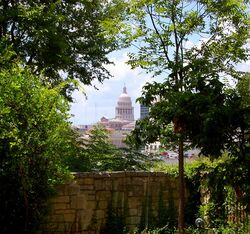Social:Texas Capitol View Corridors
| Preservation of View of State Capitol | |
|---|---|
 | |
| Texas Legislature | |
| Citation | Template:TX Govt Code |
| Enacted by | Texas Senate |
| Enacted | March 24, 1983 |
| Enacted by | Texas House of Representatives |
| Enacted | April 21, 1983 |
| Signed | May 3, 1983 |
| Signed by | Governor Mark White |
| Effective date | May 3, 1983 |
| Legislative history | |
| Bill (proposed law) introduced in the Texas Senate | Relating to preservation of the view of the State Capitol from certain points and prohibition of certain construction. |
| Bill citation | Tex. S.B. 176, 68th Leg., R.S. (1983). |
| Bill published on | January 17, 1983 |
| Introduced by | Lloyd Doggett |
| First reading | January 17, 1983 |
| Second reading | March 24, 1983 |
| Third reading | March 24, 1983 |
| Bill introduced in the Texas House of Representatives | Tex. S.B. 176, 68th Leg., R.S. (1983). |
| Bill published on | March 28, 1983 |
| Introduced by | Gerald Hill |
| First reading | April 5, 1983 |
| Second reading | April 21, 1983 |
| Third reading | April 21, 1983 |
| Amended by | |
| Tex. H.B. 2812, 77th Leg., R.S. (2001). Tex. H.B. 2256, 83rd Leg., R.S. (2013). | |
| Status: In force | |
The Capitol View Corridors are a series of legal restrictions on construction in Austin, Texas aimed at preserving the visibility of the Texas State Capitol from various points around the city. First established by the Texas Legislature in 1983 and recodified in 2001, the corridors are meant to protect the capitol dome from obstruction by high-rise buildings. The corridors significantly limit the potential for the development of new tall structures in downtown Austin.
History
In 1931, the City of Austin enacted a local ordinance limiting the height of new buildings to a maximum of 200 feet (61 m), aiming to preserve the visual preeminence of the Texas State Capitol. From that time until the early 1960s, only the University of Texas Main Building Tower was built higher than the limit, using an exception allowing for additional height with a greater setback. On November 10, 1962, the Austin Statesman announced that real-estate developers were planning a new high-rise residential building adjacent to the capitol called the Westgate Tower. The proposed design for the tower significantly exceeded the city's height limit (though it compensated with a setback for the upper portion).[1]
The prospect of so tall a structure so close to the capitol attracted significant opposition as plans proceeded. In January 1963, Texas Governor Price Daniel voiced his opposition to the proposed tower in his final address to the Texas Legislature. Resistance continued as construction progressed, with State Representative Henry Grover of Houston introducing a bill to condemn the property in February 1965, which was defeated in March in the Texas House of Representatives by only two votes. The Westgate was eventually completed in 1966, but the controversy over the preservation of the capitol's visual presence that dogged its construction continued to grow.[1]
The Westgate was followed by even taller structures: first the Dobie Center (designed in 1968), and then a series of ever larger downtown bank towers, culminating in the 395-foot (120 m) One American Center (designed in 1982).[1] In early 1983, inspired by the Westgate and these other structures, State Senator Lloyd Doggett and State Representative Gerald Hill advanced Senate Bill 176, "Relating to preservation of the view of the State Capitol from certain points and prohibition of certain construction." This bill proposed a list of protected "Capitol View Corridors" along which construction would not be permitted, so as to protect the capitol's visibility from a series of points around Austin.[2]
The bill passed through the Texas Senate and House of Representatives in the spring of 1983, ultimately being signed into law on May 3, 1983 and coming into effect immediately.[3] It was later recodified in 2001 by House Bill 2812, which established the current version of the statute in the Texas Government Code Chapter 3151, entitled "Preservation of View of State Capitol." This code defines the thirty state-protected viewing corridors and prohibits any construction that would intersect one of them.[4] The City of Austin has adopted similar rules under the Austin Code of Ordinances Chapter 25-2 Appendix A, entitled "Boundaries of the Capitol View Corridors," so that the majority of the corridors are also protected under municipal zoning code, as well as under state law.[5]
Amendments and additions
The state legislation defining the corridors was amended in 2001 and 2003 to accommodate a series of public development projects (including the redevelopment of the defunct Mueller Airport and an expansion of Darrell K Royal–Texas Memorial Stadium),[6] and again in 2013 to clarify the relationship between the state and city codes.[7]
In 2007, the Austin City Council asked the Downtown Commission to review the existing corridors and propose updates or modifications. The commission's final report, delivered on June 27, 2007, recommended that eleven of the thirty corridors be reconsidered or modified.[6] Six of the recommended changes were to correct technical errors in the statute or to bring the city and state laws into agreement, and two were to update the laws to reflect portions of the corridors that were already obstructed.[8] The other four recommendations were more controversial, attracting opposition from the city's Parks and Recreation Board,[9] the Heritage Society of Austin,[10] and others; no changes were ultimately made.
In February 2017, the Austin City Council considered a proposal from Council Member Ora Houston to designate additional protected viewing corridors in east Austin.[11] The proposal was provisionally approved by council on February 16, after an amendment removed one of the five proposed new corridors;[12] that corridor was later restored to the proposal on March 2.[13] (As of 2019), city staff are reviewing the proposed additional corridors for feasibility.[14]
Impact on development
Since their creation, the Capital View Corridors have frequently been the focus of conflict among various groups in Austin and in the Texas government. On one hand, cultural conservation and historic preservation organizations have generally supported the restrictions, arguing that the capitol views form an important part of Austin's cultural heritage and are threatened by the city's growth and land development.[15][16] On the other hand, both private and public entities looking to build in Austin (especially downtown) have expressed concern about the corridors' impact on investment, on property tax receipts, and on the supply of jobs and housing.[11][17]
Corridors
A Capitol View Corridor is a quadrilateral that links a line segment somewhere in Greater Austin to the base of the capitol dome. No structure is permitted to be built that would intersect the viewing corridor and thus obstruct the protected view of the capitol. (As of November 2017), state law defines thirty Capitol View Corridors in Austin, while municipal code defines twenty-six protected corridors, twenty-one of which are identical to state-defined corridors and five of which differ slightly from five of the state corridors.[6]
List of corridors
1: South Mall, University of Texas
Corridor #1 protects the pedestrian view from the South Mall of the University of Texas campus, nine blocks north of the capitol.[6]
2: Waterloo Park
Corridor #2 protects the pedestrian view from the sidewalk along the east edge of Waterloo Park, less than half a mile (less than one kilometer) east of the capitol.[6]
3: Wooldridge Park
Corridor #3 protects the pedestrian view from the south edge of Wooldridge Park, four blocks southwest of the capitol.[6]
4: French Legation
Corridor #4 protects the pedestrian view from the front porch of the French Legation, 3,780 feet (1,150 m) to the southeast of the capitol.[6]
5: Lamar Bridge
Corridor #5 protects the vehicular view from the Lamar Boulevard Bridge over Lady Bird Lake, 1.6 miles (2.6 km) southwest of the capitol.[6]
6: South Congress at East Live Oak
Corridor #6 protects the pedestrian and vehicular view along Congress Avenue (for which the capitol forms a terminating vista), beginning 2.4 miles (3.9 km) south of the capitol.[6]
7: MoPac Bridge
Corridor #7 protects the vehicular view from the MoPac Expressway bridge over Lady Bird Lake, from the capitol's southwest. The state and city definitions of this corridor disagree, with the state defining a longer section of the bridge as the protected viewpoint.[6]
8: South Lamar at La Casa
Corridor #8 protects the vehicular view from the northbound lanes of south Lamar Boulevard, at a point 3 miles (4.8 km) southwest of the capitol.[6]
9: Barton Creek Pedestrian Bridge
Corridor #9 protects the pedestrian view from the Barton Creek Bridge on the Ann and Roy Butler Hike-and-Bike Trail in Zilker Park, 2 miles (3.2 km) southwest of the capitol. The state and city definitions of this corridor disagree, with the state defining a point just downstream from the bridge as the protected viewpoint.[6]
10: Pleasant Valley at Lakeshore Drive
Corridor #10 protects the pedestrian view from the east end of Longhorn Shores park on the south shore of Lady Bird Lake, 2.6 miles (4.2 km) southeast of the capitol.[6]
11: East 11th Street Threshold
Corridor #11 protects the pedestrian and vehicular view from east 11th Street's elevated crossing over Interstate 35 east of the capitol.[6]
12: Northbound I-35 between the Municipal Police and Courts Building and West 10th Street
Corridor #12 protects the vehicular view from a segment of the northbound lanes of Interstate 35 southeast of the capitol. The state and city definitions of this corridor disagree, with the city defining a longer section of the highway as the protected viewpoint.[6]
13: Southbound Lanes of the Upper Deck of I-35, Concordia College to MLK, Jr. Boulevard
Corridor #13 protects the vehicular view from a segment of the elevated southbound lanes of Interstate 35 northeast of the capitol.[6]
14: Northbound I-35 between Municipal Police and Courts Building and Waller Creek Plaza
Corridor #14 protects the vehicular view from a segment of the northbound lanes of Interstate 35 southeast of the capitol.[6]
15: Northbound I-35 between 3rd Street and Waller Creek Plaza
Corridor #15 protects the vehicular view from a segment of the northbound lanes of Interstate 35 southeast of the capitol.[6]
16: East 7th Street Bridge over the Texas New Orleans Railroad
Corridor #16 protects the pedestrian and vehicular view from east 7th Street's elevated bridge over the Texas and New Orleans Railroad tracks, 12,440 feet (3,790 m) southeast of the capitol.[6]
17: Longhorn Shores
Corridor #17 protects the pedestrian view from the south edge of Longhorn Shores park on the south shore of Lady Bird Lake, 2.5 miles (4.0 km) southeast of the capitol. The state and city definitions of this corridor disagree, with the state defining a wider protected viewpoint, slightly farther north (closer to the lake).[6]
18: Zilker Clubhouse
Corridor #18 protects the pedestrian view from the plaza in front of the Zilker Clubhouse in Zilker Park.[6]
19: Redbud Trail
Corridor #19 protects the vehicular view from a hill crest along Redbud Trail in West Lake Hills, Texas, 3.4 miles (5.5 km) northwest of the capitol. The state and city definitions of this corridor disagree, with the city defining a wider protected viewpoint.[6]
20: Enfield Road
Corridor #20 protects the pedestrian and vehicular view from the eastbound lanes of Enfield Road, .9 miles (1.4 km) west of the capitol.[6]
21: Capital of Texas Highway
Corridor #21 protects the pedestrian and vehicular view from a scenic overlook on the east side of Capital of Texas Highway, 5.8 miles (9.3 km) northwest of the capitol in West Lake Hills.[6]
22: 38th and Red River
Corridor #22 protects the vehicular view from the southbound lanes of Red River Street around its intersection with 38th Street, 9,350 feet (2,850 m) north of the capitol. This corridor was partially obstructed by the addition of an upper seating deck to the east side of Darrell K Royal–Texas Memorial Stadium.[6]
23: Mueller Airport
Corridor #23 protects the pedestrian view from the base of the old air traffic control tower at the former Mueller Airport, 14,208 feet (4,331 m) northeast of the capitol. Redevelopment of the airport has been exempted from compliance with this viewing corridor.[6]
24: MLK, Jr. Boulevard at I-35
Corridor #24 protects the pedestrian and vehicular view from the westbound lanes of Martin Luther King, Jr. Boulevard at its intersection with Interstate 35, 3,500 feet (1,100 m) northeast of the capitol.[6]
25: Oakwood Cemetery
Corridor #25 protects the pedestrian and vehicular view from Comal Street as it runs through Oakwood Cemetery, 5,000 feet (1,500 m) northeast of the capitol.[6]
26: East 12th Street at I-35
Corridor #26 protects the pedestrian and vehicular view from east 12th Street's elevated crossing over Interstate 35, 3,000 feet (910 m) east of the capitol.[6]
27: LBJ Library
Corridor #27 protects the pedestrian view from the terrace of the Lyndon Baines Johnson Library and Museum on the University of Texas campus, east of the capitol. This corridor is defined only under state law (not under city ordinance) and was largely obstructed by the addition of an upper seating deck to the east side of Darrell K Royal–Texas Memorial Stadium.[6]
28: North Congress at MLK, Jr. Boulevard
Corridor #28 protects the pedestrian and vehicular view along north Congress Avenue from its intersection with Martin Luther King, Jr. Boulevard at the southern edge of the University of Texas campus, north of the capitol. This corridor is defined only under state law (not under city ordinance).[6]
29: Field Level of the Memorial Stadium Practice Center
Corridor #29 protects the pedestrian view from the practice field to the south of Darrell K Royal–Texas Memorial Stadium on the University of Texas campus, northeast of the capitol. This corridor is defined only under state law (not under city ordinance).[6]
30: Entrance Terrace, University of Texas Swim Center
Corridor #30 protects the pedestrian view from the terrace of the Lee and Joe Jamail Texas Swimming Center on the University of Texas Campus, northeast of the capitol. This corridor is defined only under state law (not under city ordinance).[6]
Additional proposed corridors
Rosewood Park and Thompson Street
This proposed corridor would protect the view from Thompson Street across Rosewood Park, east of the capitol.[11]
Lott Park
This proposed corridor would protect the view from Lott Park, east of the capitol.[11]
Texas State Cemetery
This proposed corridor would protect the view from a hillside within the Texas State Cemetery, east of the capitol.[11]
This proposed corridor would protect the view from the intersection of Juniper Street and Navasota Street, east of the capitol.[11]
Huston–Tillotson University
This proposed corridor would protect the view from the Jackson Moody Building on the Huston–Tillotson University campus, east of the capitol.[11]
References
- ↑ 1.0 1.1 1.2 "Zoning Change Review Sheet". City of Austin. http://www.austintexas.gov/edims/document.cfm?id=176342. Retrieved October 31, 2017.
- ↑ "Background on the Capitol View Corridors Issue" (PDF). https://www.preservationaustin.org/uploads/CVC_Background.pdf. Retrieved November 8, 2017.
- ↑ "SB 176, 68th Regular Session". http://www.lrl.state.tx.us/legis/billsearch/BillDetails.cfm?legSession=68-0&billTypeDetail=SB&billnumberDetail=176. Retrieved November 14, 2017.
- ↑ "Government Code Chapter 3151. Preservation of View of State Capitol". http://www.statutes.legis.state.tx.us/Docs/GV/htm/GV.3151.htm. Retrieved November 14, 2017.
- ↑ "Appendix A.: Boundaries of the Capitol View Corridors". https://library.municode.com/TX/Austin/codes/code_of_ordinances?nodeId=TIT25LADE_CH25-2ZO_APXABOCAVICO. Retrieved November 14, 2017.
- ↑ 6.00 6.01 6.02 6.03 6.04 6.05 6.06 6.07 6.08 6.09 6.10 6.11 6.12 6.13 6.14 6.15 6.16 6.17 6.18 6.19 6.20 6.21 6.22 6.23 6.24 6.25 6.26 6.27 6.28 6.29 6.30 6.31 6.32 "Downtown Development and Capitol View Corridors" (PDF). Downtown Austin Commission. June 27, 2007. https://icma.org/sites/default/files/301744_Downtown%20Development%20Comission%20Report.pdf. Retrieved November 10, 2017.
- ↑ "83(R) History for HB2256". Texas Legislature. http://www.legis.state.tx.us/BillLookup/History.aspx?LegSess=83R&Bill=HB2256. Retrieved November 14, 2017.
- ↑ Gregor, Katherine (April 13, 2007). "Revisiting the Capitol View Corridors: Where's the View?". The Austin Chronicle. https://www.austinchronicle.com/news/2007-04-13/465117/. Retrieved December 6, 2017.
- ↑ Gregor, Katherine (August 17, 2007). "Developing Stories". The Austin Chronicle. https://www.austinchronicle.com/news/2007-08-17/524359/. Retrieved December 6, 2017.
- ↑ Gregor, Katherine (June 1, 2007). "Developing Stories: The Long Capitol View". The Austin Chronicle. https://www.austinchronicle.com/news/2007-06-01/479763/. Retrieved December 6, 2017.
- ↑ 11.0 11.1 11.2 11.3 11.4 11.5 11.6 Hicks, Nolan; Novak, Shonda (February 15, 2017). "City Council considers expanding Capitol view corridors in East Austin". Austin American-Statesman. http://www.mystatesman.com/news/local-govt--politics/city-council-considers-expanding-capitol-view-corridors-east-austin/AmMaam4XUYzDxGPgDQSUbK/. Retrieved November 10, 2017.
- ↑ Craver, Jack (February 17, 2017). "Council approves resolution aimed at creating more Capitol View Corridors". Austin Monitor. https://www.austinmonitor.com/stories/2017/02/council-approves-resolution-aimed-creating-capitol-view-corridors/. Retrieved November 10, 2017.
- ↑ Neely, Christopher (March 2, 2017). "Approved Capitol View Corridor study could impact development of Central Health’s Brackenridge Campus". Community Impact Newspaper. https://communityimpact.com/austin/central-austin/city-county/2017/03/02/approved-capitol-view-corridor-study-impact-development-central-healths-brackenridge-campus/. Retrieved November 10, 2017.
- ↑ Hasan, Syeda (February 1, 2018). "How Do Capitol View Corridors Preserve Sights Of Austin's Most Famous Building?". KUT. http://kut.org/post/how-do-capitol-view-corridors-preserve-sights-austins-most-famous-building. Retrieved 1 February 2018.
- ↑ "Texas Capitol View Corridors". http://www.preservationtexas.org/endangered/texas-capitol-view-corridors/. Retrieved November 13, 2017.
- ↑ "Capitol View Corridors". https://www.preservationaustin.org/advocacy/capitol-view-corridors/. Retrieved November 13, 2017.
- ↑ McGlinchy, Audrey (February 16, 2017). "Capitol view corridors to compete at Council today". Austin Monitor. https://www.austinmonitor.com/stories/2017/02/capitol-view-corridors-compete-council-today/. Retrieved November 14, 2017.
External links
- Map of the existing and proposed Capitol View Corridors on Google Maps
 |





